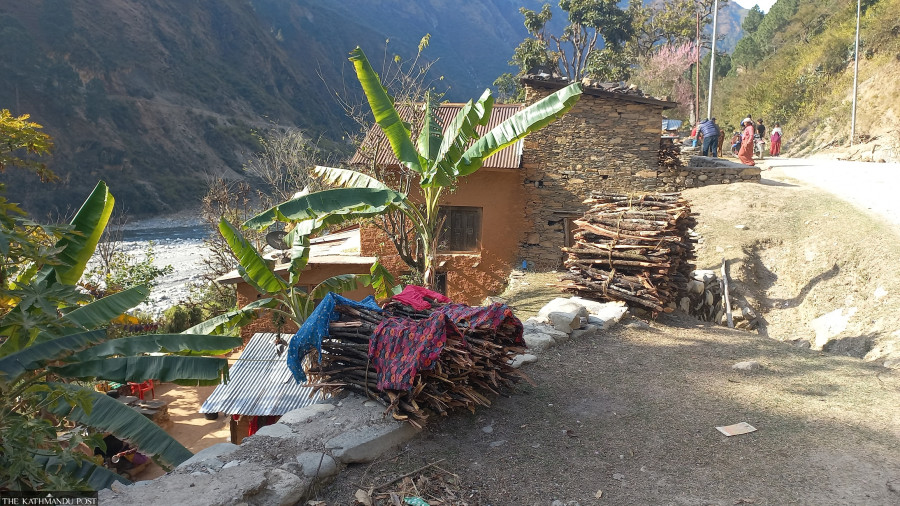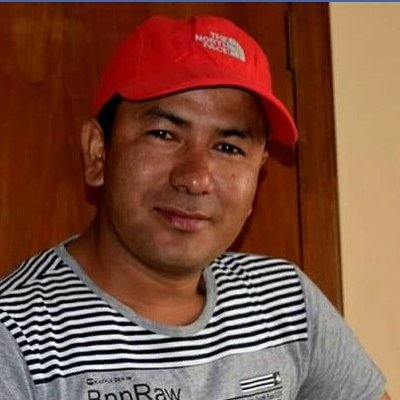Sudurpaschim Province
Flood victims in Bajhang decry government apathy
Floods victims in the district have been seeking rehabilitation in safe locations for the past two decades but no help has been forthcoming, locals say.
Basant Pratap Singh
On October 19, 2021, residents of Sungala village in Chhabis Prathivara Rural Municipality-1, Bajhang woke up to tremors. Outside, the flooded Seti River had breached its embankments and the floodwaters had started entering the village amid heavy rainfall.
Most of the houses in the settlement are flimsy huts of flood survivors from two decades ago. The huts are prone to being swept away by heavy winds, rainfall and frequent floods.
The villagers ran into the pouring rain to escape the incoming floods and gathered on the road just above the village. Meanwhile, 81-year-old Belu Giri, who needs support to walk, was left alone inside her house since her son was not home that night.
Giri somehow managed to crawl to the door but could not step outside since the floodwaters from the Seti River had already entered the settlement.
“The river had already breached its embankments. I could see the floodwaters sweeping away our toilet, a short distance from the main house. I froze. Water had started seeping into the house and boulders as big as our house were being carried by the angry river,” she said. “The ground was shaking like we were hit by an earthquake. The last thing I remember before passing out at the door was the river advancing towards me. I don’t know what happened next.”
Giri was soon rescued by the villagers who had found her missing that night. This was her second near-death experience.
Giri remembers a similar incident that had occurred 21 years ago on June 10, 2000.
“It had been raining all day and night but nothing was out of the ordinary. However, at around 8:30pm, the Seti River breached its embankments and flood waters entered our village. The force of the water started washing away houses, trees, temples and everything that was in its path,” said Giri. “I heard the goats bleat and ran towards the shed to free them. In a matter of seconds, the river was upon me. But someone pulled me away and saved me. It felt like I was reborn.”
Giri somehow survived that day but lost everything. In an hour’s time, both Sungala and Afla villages perished in the floods. Not a single house was left standing.
There are over two dozen people in Sungala village who have had experiences similar to Giri’s. Since the flood in 2000, the villagers have been moving from one place to another fleeing floods from the Seti River with no help from the authorities for their rehabilitation and safety.
Since 2000, more than 400 families have been displaced by floods in Paringal, Sungala, Malumela and Dhami Chhana villages of Chhabis Pathivara Rural Municipality and Afla, Aambagar and Jadar villages of Thalara Rural Municipality. The displaced have been living in temporary huts by the roadside and on the riverbanks during the dry season.
The October floods of last year swept away the houses of 16 families living in Sungala, Malumela and Dhamichhana villages and washed away 405,600 sq m of land belonging to 270 families. The river has now started cutting into the landmass upon which 65 houses sit.
“Around 14 to 15 families who used to live near the Seti River have left the area for good. Some of the displaced families are living with their relatives while the others have put up tents in the forest area, away from the river,” said Daman Damai, one of the recent flood victims. “I have a family of eight, including small children. I can neither move my family elsewhere nor take shelter with my relatives so I have been staying in a temporary shelter. We have nowhere else to go. We get hit by floods every year but last year’s floods devastated us.”
The villagers, who have constantly been living in fear of floods for the past 21 years, have nowhere to turn to for help since the authorities concerned have shown no interest in resettling them to safe locations. Back in 2000, when the floods destroyed their villages, the locals had staged a two-day sit-in in front of the Bajhang District Administration Office demanding relocation. But the administration accused the protesters of being political party workers and warned of consequences if they continued. After the unsuccessful sit-in protest, most of the flood victims moved south to Kailali district searching for safe locations and ended up in the district’s forest areas. But there too, they were accused of being encroachers and got chased away from their temporary shelters. After that, most of the victims returned to Bajhang and started living under temporary huts along the Jaya Prithvi Highway.
“We lost all our farmlands and ancestral properties 21 years ago. We had to flee our villages and since then have been living in temporary shelters along the highway and by the riverbanks. But the October floods last year robbed us of even that option,” said 60-year-old Dhanu Giri. “I have lived half my life in the hopes of rehabilitation. But that seems highly unlikely. The government has done nothing for us in the past two decades.”
In the absence of government intervention for their rehabilitation, more than 30 families have left the area and moved to India permanently while the ones who have chosen to stay back have spent years frequenting ward offices, local government offices, and the district administration office demanding relocation.
“It’s been 21 years since the flood in the Seti River changed our lives. Since then, we have been running from one place to another, hoping to find a home for ourselves. Flood victims are suffering greatly but the government has not done anything to ease our pain,” said Ram Bhakta Giri, chairman of the Flood Victims’ Struggle Committee Bajhang. “Six months ago, we had to flee from the floods again and we have been running from pillar to post since but no one is listening to us.”
Meanwhile, the families whose property were partially damaged by the floods are also awaiting relief and compensation from the government. But since theirs was only a partial loss, they do not qualify for relief and are hence left without support to sustain their livelihoods.
“We are aware of the difficulties the flood victims are facing but we cannot provide relief to them since they still have their houses intact,” said Nayan Bohara, ward chair of Chhabis Pathivera Rural Municipality-1. “The federal government should intervene in this matter so that we can have sufficient resources to compensate those whose properties were destroyed by floods and relocate those families who are at high risk.”



 15.24°C Kathmandu
15.24°C Kathmandu













